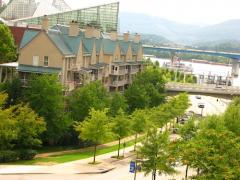Trees provide the greatest energy conservation benefit when they are found in every part of urban landscapes, yards, businesses, parking lots, along streets, and in parks and green spaces. Trees create shade and, when properly placed in urban settings, the shade produced by trees can reduce energy use in homes, offices, and other buildings. Trees near air-conditioned buildings are the highest priority for energy conservation, but having trees distributed across the entire built environment is important, because they can create cooling effects for larger areas by reducing the urban heat island effect.
 |
How Do Trees Help Conserve Energy?
|
| Photo Credit: Raina Sheridan |
Trees reduce this heat island effect by reflecting green light and absorbing ultraviolet and near-infrared light, converting solar energy into chemical energy through photosynthesis, thereby dissipating the heat gain. In contrast, dark surfaces (asphalt, tar, gravel, brick) absorb the majority of solar energy that shines upon them and retain much of this energy for long periods of time. This trapped heat re-radiates into the surroundings, elevating daytime temperatures and reducing cool-down at nighttime. A continuum of trees across urban landscapes provides shade, increases the reflection of radiant energy, and reduces absorption of heat by structures and pavement found in urban areas.
An important component of urban forestry, the management of trees in an urban setting, is managing trees in communities to increase energy conservation and reduce the urban heat island effect. Urban foresters manage not just one tree, but the entire tree population in an area. Urban foresters can design and manage areas of contiguous shade, resulting in reduction in the urban heat island effect. The benefits of this management strategy range from individual home and business energy savings to community-wide energy savings from the cooling effects of a well-managed urban forest.
Providing for green spaces within our cities for energy conservation also creates a myriad of other economic, environmental, and social benefits that make this a cost-effective investment.
weblink: www.sustainablecitiesnet.com
By: Mary Carol Sheffield, Agriculture and Natural Resources Extension Agent, University of Georgia
